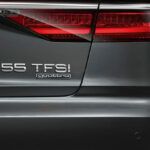Audi’s Number Game – When Logic Becomes an Art Form
In 2017, Audi, those meticulous masterminds of German engineering, decided to introduce a naming convention that would leave the rest of us scratching our heads. You’d think the Germans would keep things simple: horsepower on the badge, maybe displacement, or at least the familiar S, RS, or quattro. But no. They went full Wagner opera with a numeric scale that somehow manages to be both precise and maddeningly cryptic at the same time.
According to Audi’s press release, the goal was to create a “consistent and logical structure” for model designations. Logical? Perhaps, if you happen to be a product planner in Ingolstadt. For the rest of us, it felt like an engineering riddle, a secret code daring loyal customers to decode their own cars. The plan was simple on paper: numbers from 30 to 70 corresponding to power output bands, independent of displacement, cylinder count, or induction type. Goodbye “2.0T,” hello abstract mathematics.
The Scale of Ingolstadt Logic
- 30 = 109–128 hp (81–96 kW) – For those who enjoy sipping fuel and blending in quietly.
- 35 = 147–160 hp (110–120 kW) – Enough punch to remind you it’s still an Audi, not a taxi.
- 40 = 167–201 hp (125–150 kW) – Autobahn entry level: capable of left-lane respectability.
- 45 = 226–248 hp (169–185 kW) – The point where an Audi starts to feel properly quick.
- 50 = 281–308 hp (210–230 kW) – Strong performance without full RS drama.
- 55 = 328–368 hp (245–275 kW) – The “statement” zone: every throttle press says you mean it.
- 60 = 429–455 hp (320–340 kW) – Serious power. The kind neighbours ask awkward questions about.
- 70 = 536+ hp (400+ kW) – RS-level savagery; where Audi stops pretending to be subtle.
Power Bands and Confusion
And, in true German fashion, there’s nuance. Hybrids, diesels, petrols, even electric e-trons, all slot somewhere onto this scale. You could have a “45 TDI” or a “45 TFSI,” both with the same number yet entirely different personalities. Confused? That’s the idea. Audi insisted the badge represented “performance equivalence,” not what’s under the bonnet.
The reaction was predictable: enthusiasts groaned, journalists rolled their eyes, and buyers nodded politely while pretending to understand. Yet Audi never wavered. For them, it wasn’t about simplicity, it was about order. A very German order, where logic is absolute, clarity optional, and the rest of the world can keep up if it likes.
In Context: Everyone’s Guilty
To be fair, Audi wasn’t alone. BMW has long called a 2.0-litre turbo a “330i,” and Mercedes happily sells an “E300” with a four-cylinder. At least Audi dropped the displacement pretense entirely. In its own convoluted way, their numeric system might actually be the most honest, if you’re fluent in Ingolstadt, that is.
The Final Word
Was it necessary? Probably not. Did it make life confusing? Absolutely. But like so many things Audi does, the brilliance lies in the arrogance: if you don’t get it, perhaps you weren’t meant to. Because nothing says Vorsprung durch Technik quite like a numbering system that keeps everyone guessing, ja?
